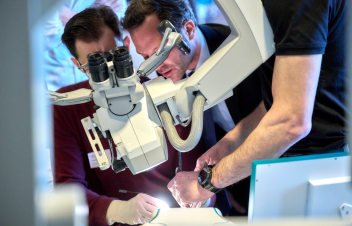Navigating Radiation Therapy: A Deep Dive into CT Simulation Techniques
- surgeonslab1
- May 17, 2024
- 3 min read
Updated: May 24, 2024

Radiation therapy is a highly effective weapon in our fight against cancer, which is aimed at having specifically tailored doses of radiation treatments that will shrink tumors and kill the cancer cells. Therefore, the exact and correct targeting of the treatment is essential in order to ensure the maximization of effectiveness while minimizing the consequences of damage to healthy nearby tissues. It is where CT simulation for radiation therapy fits in, and this is precisely the critical step in radiation therapy planning that utilizes computed tomography (CT) imaging technology.
The Cornerstone of Treatment Planning:
CT simulation involves obtaining high-resolution 3D images of the patient's anatomy, including the tumor, surrounding organs, and bony structures. This detailed information serves as the foundation for treatment planning. Radiation oncologists use these images to precisely define the target area for radiation delivery, ensuring accurate beam direction and dose distribution.
The significance of CT simulation extends beyond treatment planning.
Medical residents in radiation oncology programs heavily rely on CT simulation training to develop the necessary skills for patient positioning, image acquisition, and treatment plan creation. Mastering these techniques translates to improved patient care and treatment outcomes.
Understanding the Fundamentals
CT simulation starts with precise patient positioning and locking of the device using a mold or cushion. This reduces motion during scanning and thus ensures image accuracy. Next, the CT scanner obtains a series of X-ray pictures from different directions, which are rearranged into anatomical images with desirable details. This data is processed and transferred to treatment planning systems automatically, which enables the development of a treatment plan that is tailored to the patient's individual needs.
Technical Nuances of CT Simulation
We can do CT scans using either contrast-enhanced or non-contrast methods. Contrast agents help visibility of specific biometric structures, which provides for clear tumor disfigurement. However, CT images can be better understood by combining CT simulation data with data from other modalities, such as MRI or PET scans, and more tumor-specific characteristics and functional activity could be shown.
CT simulation for radiation therapy involves a critical step of defining the target regions, delineating both the tumor and its microscopic spread, and the organs at risk (OARs), which are tissues commonly found in the body, leading to radiation injury. The detailed boundaries of radiation concentration reduce collateral damage and improve the level of the patient's endurance throughout the treatment.
Furthermore, 4D CT simulation has emerged as a valuable tool for addressing organ motion caused by breathing or other physiological processes. This technique captures multiple images at different points in the respiratory cycle, allowing for treatment plans that account for organ movement and deliver more targeted radiation.
Optimizing Protocols and Parameters
CT simulation protocols are carefully tailored to specific cancer types. The scanning parameters, including the slice thickness and the field of view, are fine-tuned in order to accomplish the same level of image quality and radiation exposure reduction. Consequently, an anthropomorphic phantom, which is a life-size dummy mimicking human anatomy, is used in dosimetric planning to find out the correct dose calculations before treatment commences.
The Future Landscape
CT simulation is a field that is developing on the basis of software and imaging technology improvements all the time. Artificial intelligence and machine learning are giving rise to CT simulation; autonomy for tasks such as image segmentation and treatment plan optimization are the tools the innovation offers. VR and 3D printing profoundly change training techniques; residents can use the first one for treatment planning in a computer-made environment and the other one for viewing complex anatomical structures.
Integration into Medical Residency Training
Concepts and techniques related to CT simulation simulate almost all phases of the medical residency training. Residents work on the practical aspect of patient placement, image acquisition, and treatment plan development by using actual patients during their training. Through the medical procedures competency assessment, a resident can build his/her confidence regarding performing the procedures before encountering a real-life emergency. Simulation-based education models the learning process through a risk-free setting where residents are equipped with the essential skills to deal with critical matters, thus leading to a safer patient experience with positive results.
Challenges and Considerations
Balancing the need for high-quality images with minimizing radiation exposure during CT simulation remains a crucial consideration. Additionally, residents face a learning curve when mastering these complex techniques. Ethical considerations and obtaining informed patient consent for CT simulation procedures are paramount.
To Conclude
CT simulation is the foundation of precise radiation therapy. Through high-definition anatomy, it allows for highly targeted and customized treatment plans provided by radiation oncologists. With further development of technology, CT simulation will obviously be of more benefit in ensuring the treatment of deaths and minimizing the side effects.
Additionally, providing adequate medical residency training for the next generation of healthcare providers by means of improved simulation training systems will also be of extreme importance as it will aid in improving patient care and dealing with the challenges of dispensing radiation treatment as system complexity evolves.







